MN3041QA Project 3: Literature Review on Motivation at Work
VerifiedAdded on 2022/12/17
|5
|1293
|92
Report
AI Summary
This report presents a literature review on motivation at work, focusing on various theories, benefits, and disadvantages of employee motivation. The introduction defines motivation and its importance in achieving organizational goals. The literature review section explores different perspectives on motivation, including the Onputtha and Chienwattanasook's view on motivation as a tool to increase energy levels. It also delves into the benefits of motivation, such as improved relationships and productivity, as well as the disadvantages of unmotivated employees. The report further discusses Maslow's hierarchy of needs, ERG theory, two-factor theory, and acquired needs theory, along with the concepts of intrinsic and extrinsic motivation. The conclusion emphasizes the necessity of motivation in the workplace and how different methods can be employed to inspire employees, highlighting the benefits for both the organization and the employees. The report is concluded with a bibliography of all the sources referenced within the document.
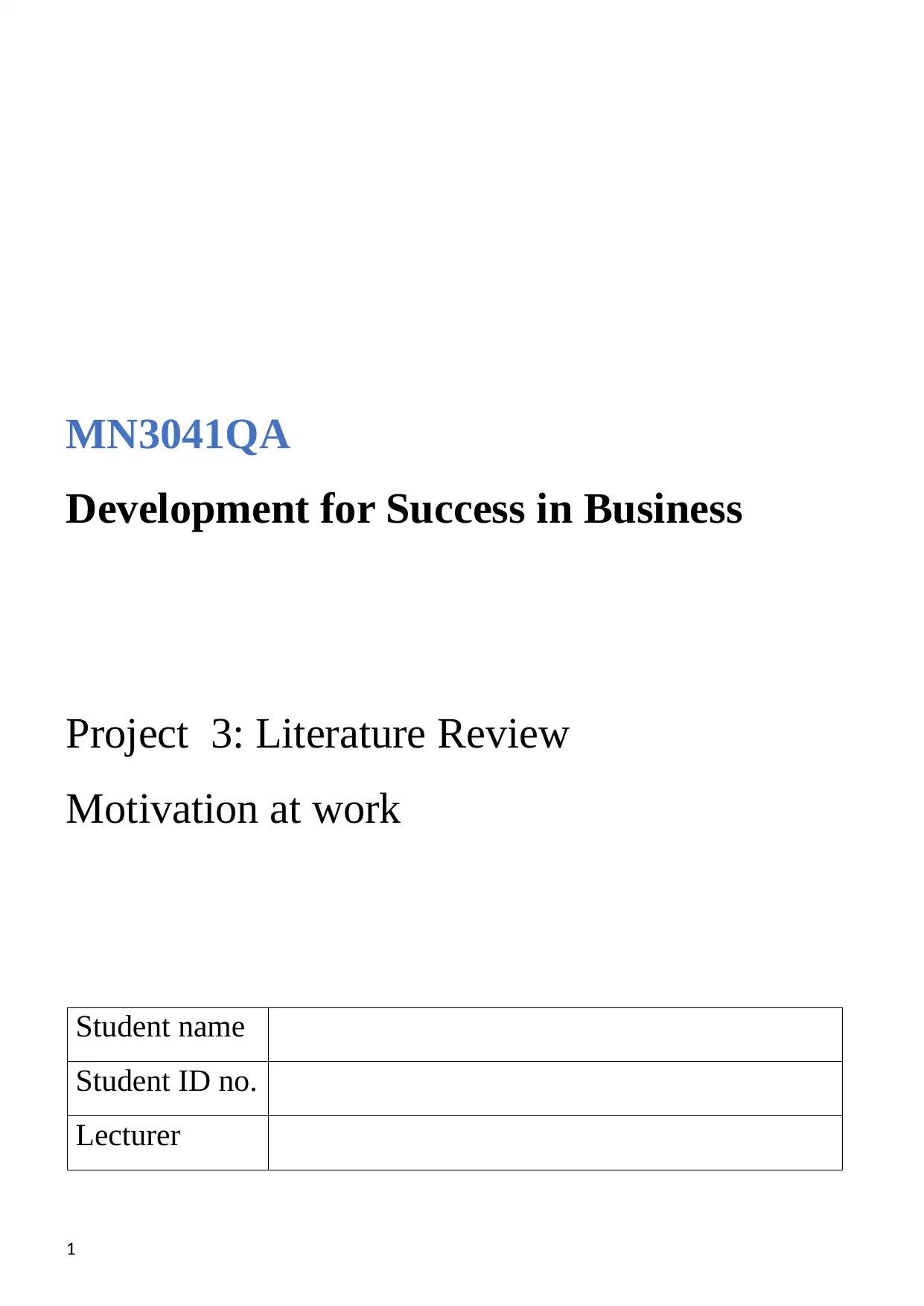
MN3041QA
Development for Success in Business
Project 3: Literature Review
Motivation at work
Student name
Student ID no.
Lecturer
1
Development for Success in Business
Project 3: Literature Review
Motivation at work
Student name
Student ID no.
Lecturer
1
Paraphrase This Document
Need a fresh take? Get an instant paraphrase of this document with our AI Paraphraser
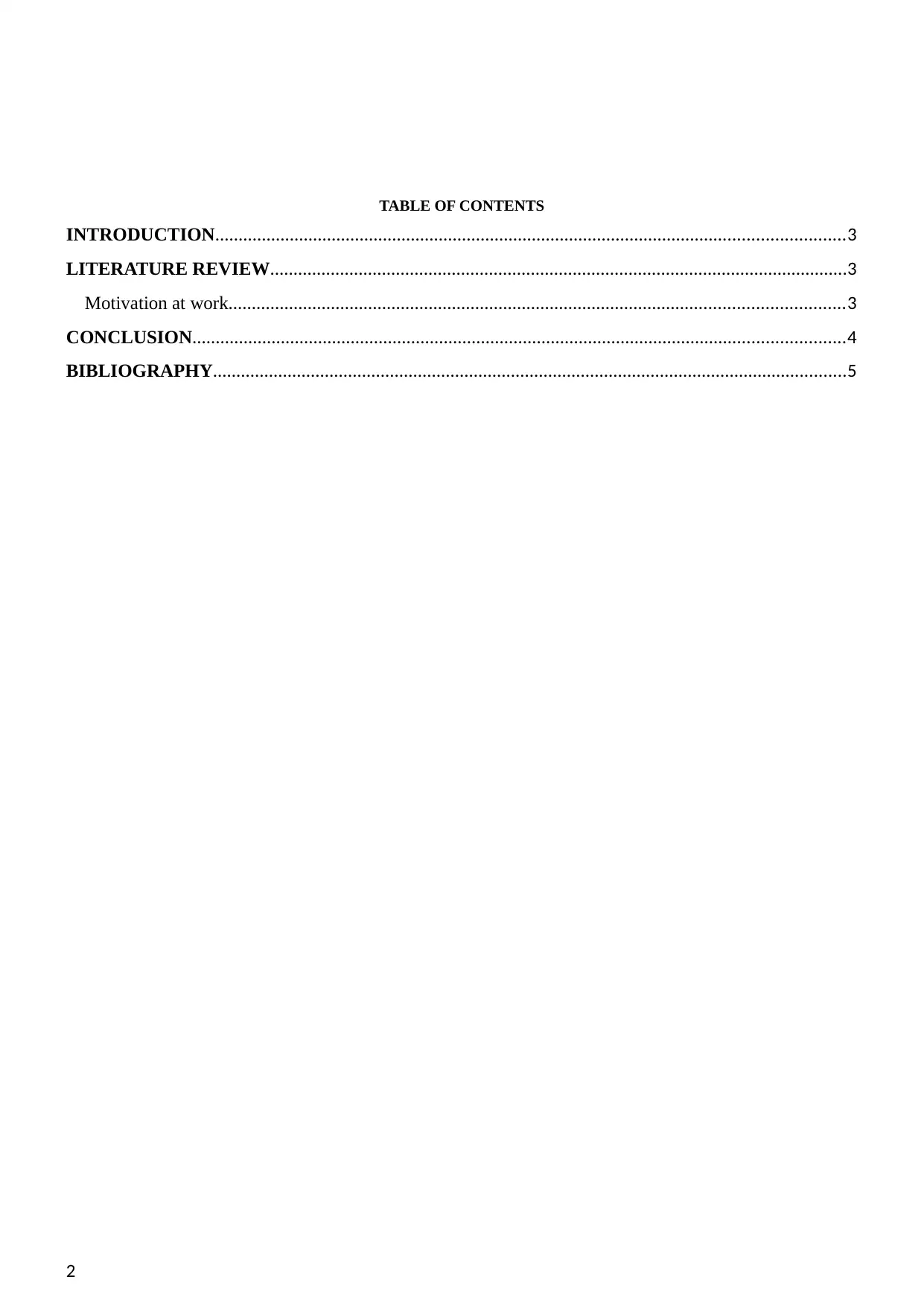
TABLE OF CONTENTS
INTRODUCTION.......................................................................................................................................3
LITERATURE REVIEW............................................................................................................................3
Motivation at work....................................................................................................................................3
CONCLUSION............................................................................................................................................4
BIBLIOGRAPHY........................................................................................................................................5
2
INTRODUCTION.......................................................................................................................................3
LITERATURE REVIEW............................................................................................................................3
Motivation at work....................................................................................................................................3
CONCLUSION............................................................................................................................................4
BIBLIOGRAPHY........................................................................................................................................5
2
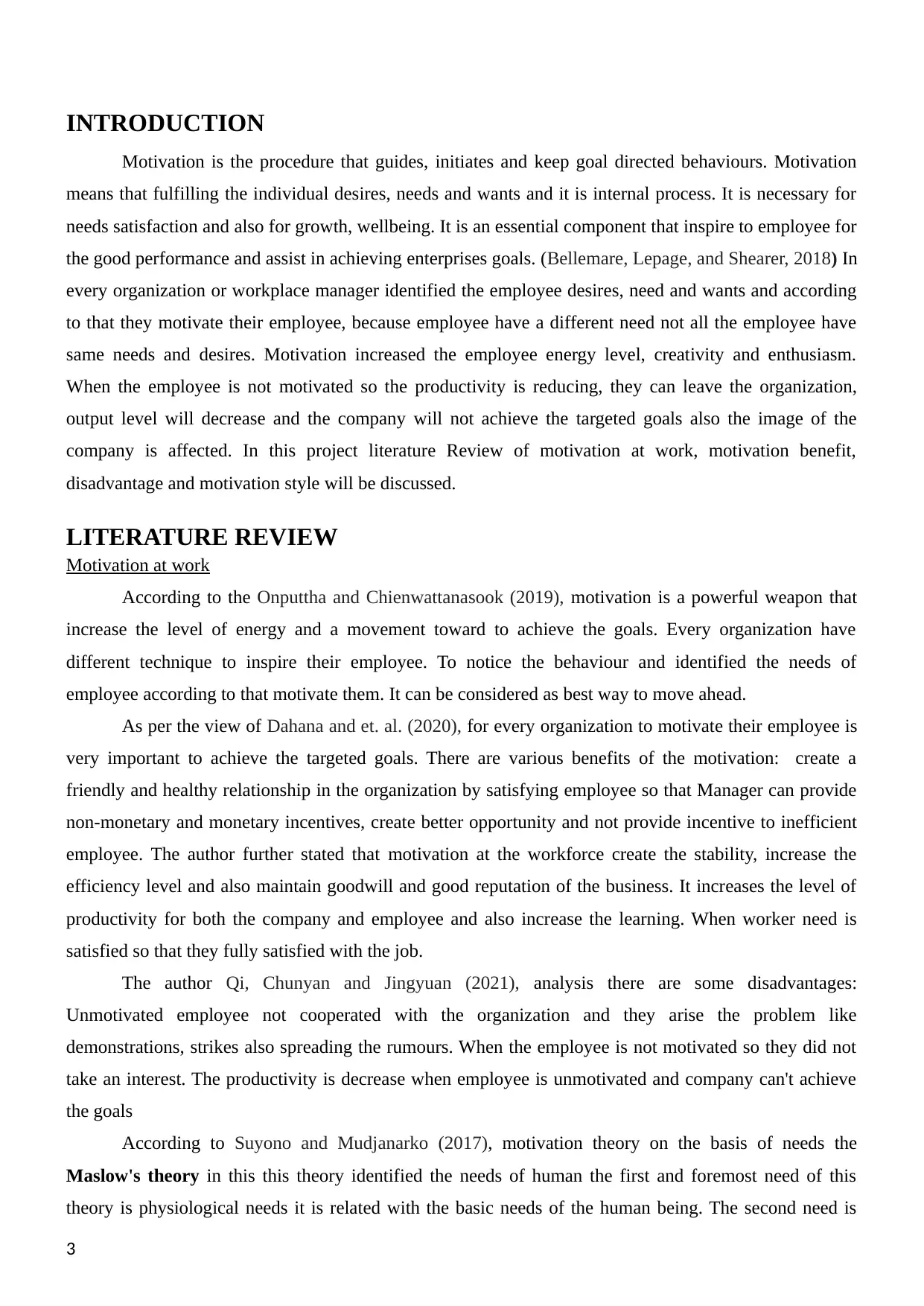
INTRODUCTION
Motivation is the procedure that guides, initiates and keep goal directed behaviours. Motivation
means that fulfilling the individual desires, needs and wants and it is internal process. It is necessary for
needs satisfaction and also for growth, wellbeing. It is an essential component that inspire to employee for
the good performance and assist in achieving enterprises goals. (Bellemare, Lepage, and Shearer, 2018) In
every organization or workplace manager identified the employee desires, need and wants and according
to that they motivate their employee, because employee have a different need not all the employee have
same needs and desires. Motivation increased the employee energy level, creativity and enthusiasm.
When the employee is not motivated so the productivity is reducing, they can leave the organization,
output level will decrease and the company will not achieve the targeted goals also the image of the
company is affected. In this project literature Review of motivation at work, motivation benefit,
disadvantage and motivation style will be discussed.
LITERATURE REVIEW
Motivation at work
According to the Onputtha and Chienwattanasook (2019), motivation is a powerful weapon that
increase the level of energy and a movement toward to achieve the goals. Every organization have
different technique to inspire their employee. To notice the behaviour and identified the needs of
employee according to that motivate them. It can be considered as best way to move ahead.
As per the view of Dahana and et. al. (2020), for every organization to motivate their employee is
very important to achieve the targeted goals. There are various benefits of the motivation: create a
friendly and healthy relationship in the organization by satisfying employee so that Manager can provide
non-monetary and monetary incentives, create better opportunity and not provide incentive to inefficient
employee. The author further stated that motivation at the workforce create the stability, increase the
efficiency level and also maintain goodwill and good reputation of the business. It increases the level of
productivity for both the company and employee and also increase the learning. When worker need is
satisfied so that they fully satisfied with the job.
The author Qi, Chunyan and Jingyuan (2021), analysis there are some disadvantages:
Unmotivated employee not cooperated with the organization and they arise the problem like
demonstrations, strikes also spreading the rumours. When the employee is not motivated so they did not
take an interest. The productivity is decrease when employee is unmotivated and company can't achieve
the goals
According to Suyono and Mudjanarko (2017), motivation theory on the basis of needs the
Maslow's theory in this this theory identified the needs of human the first and foremost need of this
theory is physiological needs it is related with the basic needs of the human being. The second need is
3
Motivation is the procedure that guides, initiates and keep goal directed behaviours. Motivation
means that fulfilling the individual desires, needs and wants and it is internal process. It is necessary for
needs satisfaction and also for growth, wellbeing. It is an essential component that inspire to employee for
the good performance and assist in achieving enterprises goals. (Bellemare, Lepage, and Shearer, 2018) In
every organization or workplace manager identified the employee desires, need and wants and according
to that they motivate their employee, because employee have a different need not all the employee have
same needs and desires. Motivation increased the employee energy level, creativity and enthusiasm.
When the employee is not motivated so the productivity is reducing, they can leave the organization,
output level will decrease and the company will not achieve the targeted goals also the image of the
company is affected. In this project literature Review of motivation at work, motivation benefit,
disadvantage and motivation style will be discussed.
LITERATURE REVIEW
Motivation at work
According to the Onputtha and Chienwattanasook (2019), motivation is a powerful weapon that
increase the level of energy and a movement toward to achieve the goals. Every organization have
different technique to inspire their employee. To notice the behaviour and identified the needs of
employee according to that motivate them. It can be considered as best way to move ahead.
As per the view of Dahana and et. al. (2020), for every organization to motivate their employee is
very important to achieve the targeted goals. There are various benefits of the motivation: create a
friendly and healthy relationship in the organization by satisfying employee so that Manager can provide
non-monetary and monetary incentives, create better opportunity and not provide incentive to inefficient
employee. The author further stated that motivation at the workforce create the stability, increase the
efficiency level and also maintain goodwill and good reputation of the business. It increases the level of
productivity for both the company and employee and also increase the learning. When worker need is
satisfied so that they fully satisfied with the job.
The author Qi, Chunyan and Jingyuan (2021), analysis there are some disadvantages:
Unmotivated employee not cooperated with the organization and they arise the problem like
demonstrations, strikes also spreading the rumours. When the employee is not motivated so they did not
take an interest. The productivity is decrease when employee is unmotivated and company can't achieve
the goals
According to Suyono and Mudjanarko (2017), motivation theory on the basis of needs the
Maslow's theory in this this theory identified the needs of human the first and foremost need of this
theory is physiological needs it is related with the basic needs of the human being. The second need is
3
⊘ This is a preview!⊘
Do you want full access?
Subscribe today to unlock all pages.

Trusted by 1+ million students worldwide
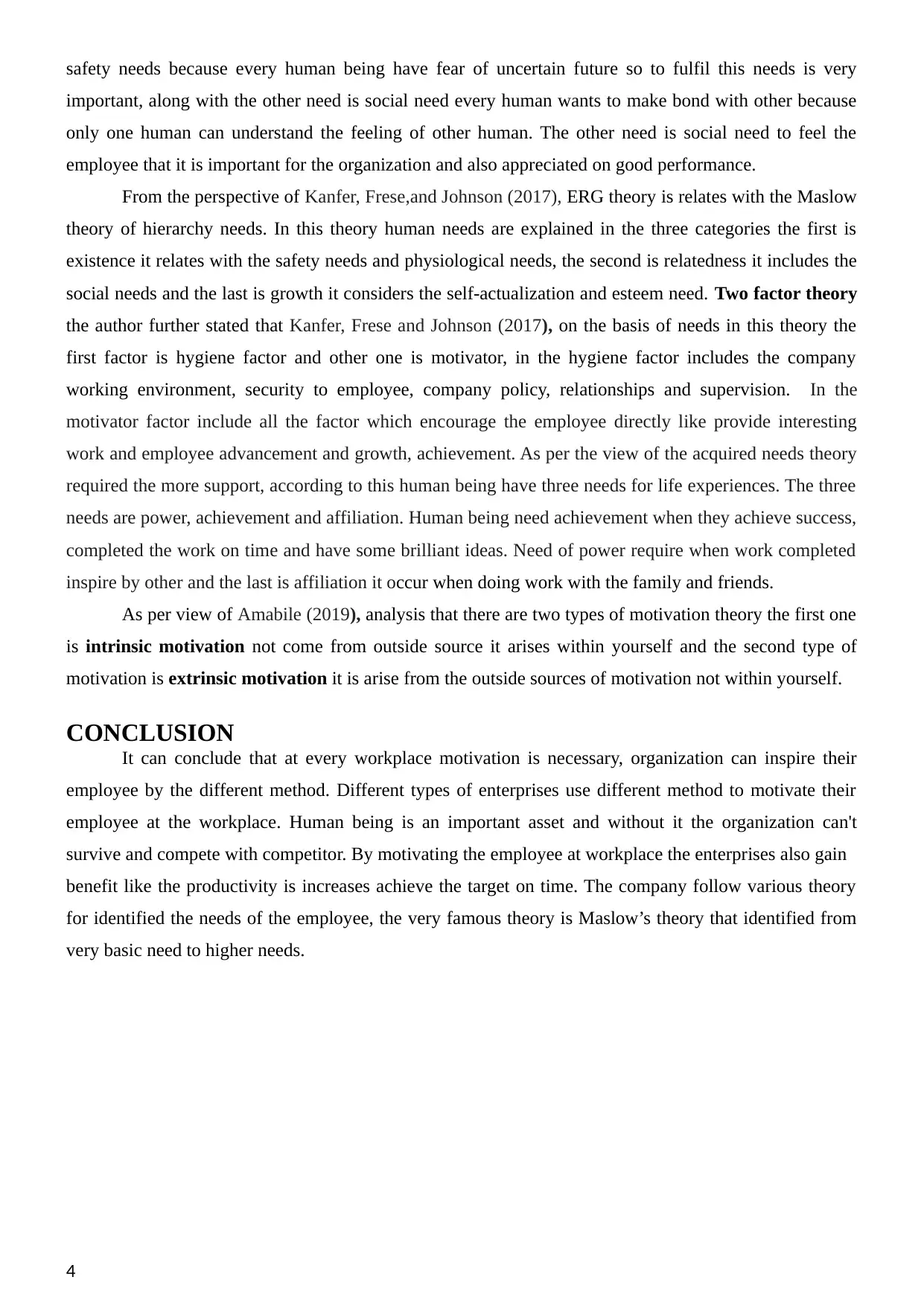
safety needs because every human being have fear of uncertain future so to fulfil this needs is very
important, along with the other need is social need every human wants to make bond with other because
only one human can understand the feeling of other human. The other need is social need to feel the
employee that it is important for the organization and also appreciated on good performance.
From the perspective of Kanfer, Frese,and Johnson (2017), ERG theory is relates with the Maslow
theory of hierarchy needs. In this theory human needs are explained in the three categories the first is
existence it relates with the safety needs and physiological needs, the second is relatedness it includes the
social needs and the last is growth it considers the self-actualization and esteem need. Two factor theory
the author further stated that Kanfer, Frese and Johnson (2017), on the basis of needs in this theory the
first factor is hygiene factor and other one is motivator, in the hygiene factor includes the company
working environment, security to employee, company policy, relationships and supervision. In the
motivator factor include all the factor which encourage the employee directly like provide interesting
work and employee advancement and growth, achievement. As per the view of the acquired needs theory
required the more support, according to this human being have three needs for life experiences. The three
needs are power, achievement and affiliation. Human being need achievement when they achieve success,
completed the work on time and have some brilliant ideas. Need of power require when work completed
inspire by other and the last is affiliation it occur when doing work with the family and friends.
As per view of Amabile (2019), analysis that there are two types of motivation theory the first one
is intrinsic motivation not come from outside source it arises within yourself and the second type of
motivation is extrinsic motivation it is arise from the outside sources of motivation not within yourself.
CONCLUSION
It can conclude that at every workplace motivation is necessary, organization can inspire their
employee by the different method. Different types of enterprises use different method to motivate their
employee at the workplace. Human being is an important asset and without it the organization can't
survive and compete with competitor. By motivating the employee at workplace the enterprises also gain
benefit like the productivity is increases achieve the target on time. The company follow various theory
for identified the needs of the employee, the very famous theory is Maslow’s theory that identified from
very basic need to higher needs.
4
important, along with the other need is social need every human wants to make bond with other because
only one human can understand the feeling of other human. The other need is social need to feel the
employee that it is important for the organization and also appreciated on good performance.
From the perspective of Kanfer, Frese,and Johnson (2017), ERG theory is relates with the Maslow
theory of hierarchy needs. In this theory human needs are explained in the three categories the first is
existence it relates with the safety needs and physiological needs, the second is relatedness it includes the
social needs and the last is growth it considers the self-actualization and esteem need. Two factor theory
the author further stated that Kanfer, Frese and Johnson (2017), on the basis of needs in this theory the
first factor is hygiene factor and other one is motivator, in the hygiene factor includes the company
working environment, security to employee, company policy, relationships and supervision. In the
motivator factor include all the factor which encourage the employee directly like provide interesting
work and employee advancement and growth, achievement. As per the view of the acquired needs theory
required the more support, according to this human being have three needs for life experiences. The three
needs are power, achievement and affiliation. Human being need achievement when they achieve success,
completed the work on time and have some brilliant ideas. Need of power require when work completed
inspire by other and the last is affiliation it occur when doing work with the family and friends.
As per view of Amabile (2019), analysis that there are two types of motivation theory the first one
is intrinsic motivation not come from outside source it arises within yourself and the second type of
motivation is extrinsic motivation it is arise from the outside sources of motivation not within yourself.
CONCLUSION
It can conclude that at every workplace motivation is necessary, organization can inspire their
employee by the different method. Different types of enterprises use different method to motivate their
employee at the workplace. Human being is an important asset and without it the organization can't
survive and compete with competitor. By motivating the employee at workplace the enterprises also gain
benefit like the productivity is increases achieve the target on time. The company follow various theory
for identified the needs of the employee, the very famous theory is Maslow’s theory that identified from
very basic need to higher needs.
4
Paraphrase This Document
Need a fresh take? Get an instant paraphrase of this document with our AI Paraphraser
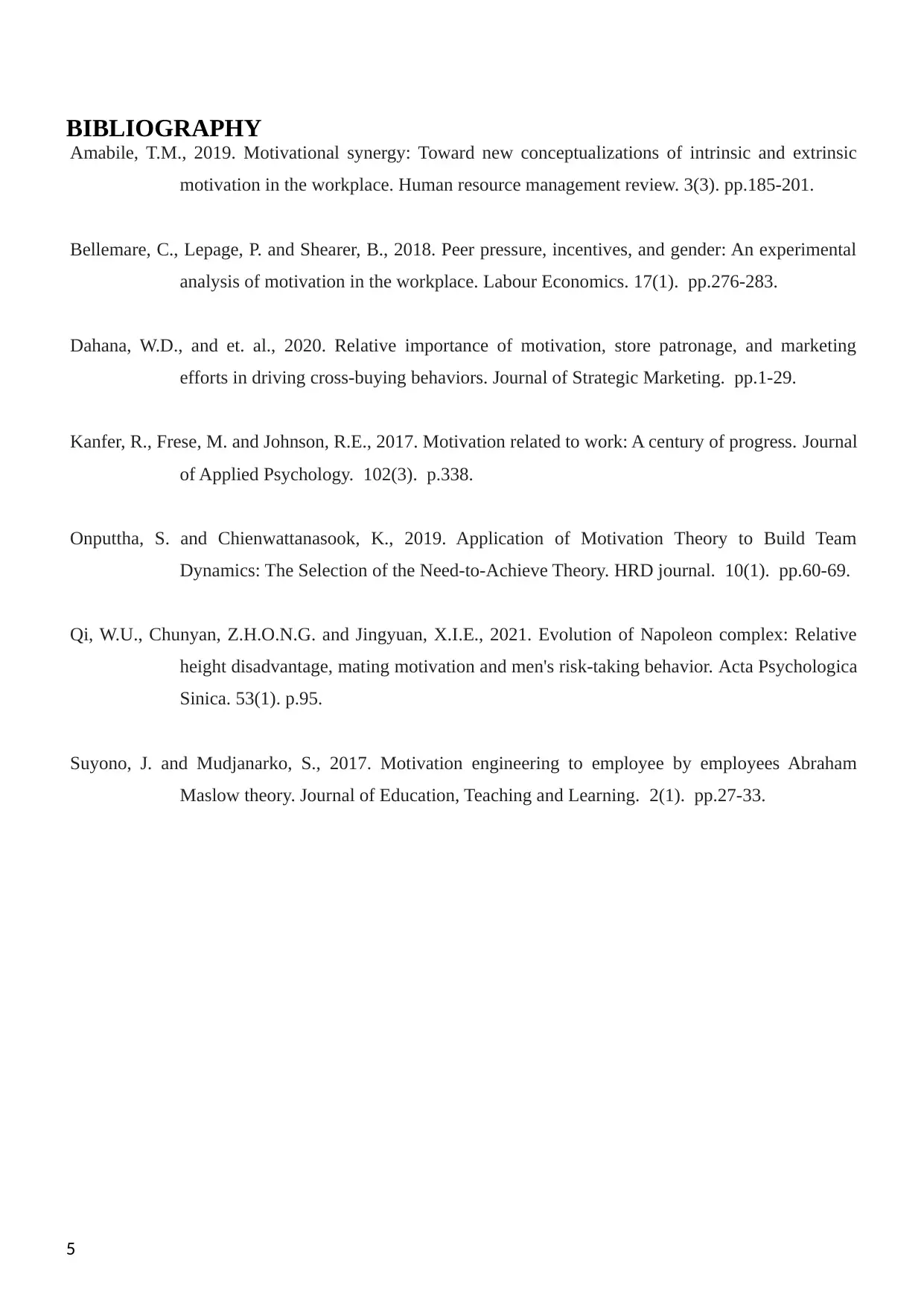
BIBLIOGRAPHY
Amabile, T.M., 2019. Motivational synergy: Toward new conceptualizations of intrinsic and extrinsic
motivation in the workplace. Human resource management review. 3(3). pp.185-201.
Bellemare, C., Lepage, P. and Shearer, B., 2018. Peer pressure, incentives, and gender: An experimental
analysis of motivation in the workplace. Labour Economics. 17(1). pp.276-283.
Dahana, W.D., and et. al., 2020. Relative importance of motivation, store patronage, and marketing
efforts in driving cross-buying behaviors. Journal of Strategic Marketing. pp.1-29.
Kanfer, R., Frese, M. and Johnson, R.E., 2017. Motivation related to work: A century of progress. Journal
of Applied Psychology. 102(3). p.338.
Onputtha, S. and Chienwattanasook, K., 2019. Application of Motivation Theory to Build Team
Dynamics: The Selection of the Need-to-Achieve Theory. HRD journal. 10(1). pp.60-69.
Qi, W.U., Chunyan, Z.H.O.N.G. and Jingyuan, X.I.E., 2021. Evolution of Napoleon complex: Relative
height disadvantage, mating motivation and men's risk-taking behavior. Acta Psychologica
Sinica. 53(1). p.95.
Suyono, J. and Mudjanarko, S., 2017. Motivation engineering to employee by employees Abraham
Maslow theory. Journal of Education, Teaching and Learning. 2(1). pp.27-33.
5
Amabile, T.M., 2019. Motivational synergy: Toward new conceptualizations of intrinsic and extrinsic
motivation in the workplace. Human resource management review. 3(3). pp.185-201.
Bellemare, C., Lepage, P. and Shearer, B., 2018. Peer pressure, incentives, and gender: An experimental
analysis of motivation in the workplace. Labour Economics. 17(1). pp.276-283.
Dahana, W.D., and et. al., 2020. Relative importance of motivation, store patronage, and marketing
efforts in driving cross-buying behaviors. Journal of Strategic Marketing. pp.1-29.
Kanfer, R., Frese, M. and Johnson, R.E., 2017. Motivation related to work: A century of progress. Journal
of Applied Psychology. 102(3). p.338.
Onputtha, S. and Chienwattanasook, K., 2019. Application of Motivation Theory to Build Team
Dynamics: The Selection of the Need-to-Achieve Theory. HRD journal. 10(1). pp.60-69.
Qi, W.U., Chunyan, Z.H.O.N.G. and Jingyuan, X.I.E., 2021. Evolution of Napoleon complex: Relative
height disadvantage, mating motivation and men's risk-taking behavior. Acta Psychologica
Sinica. 53(1). p.95.
Suyono, J. and Mudjanarko, S., 2017. Motivation engineering to employee by employees Abraham
Maslow theory. Journal of Education, Teaching and Learning. 2(1). pp.27-33.
5
1 out of 5
Related Documents
Your All-in-One AI-Powered Toolkit for Academic Success.
+13062052269
info@desklib.com
Available 24*7 on WhatsApp / Email
![[object Object]](/_next/static/media/star-bottom.7253800d.svg)
Unlock your academic potential
Copyright © 2020–2025 A2Z Services. All Rights Reserved. Developed and managed by ZUCOL.





